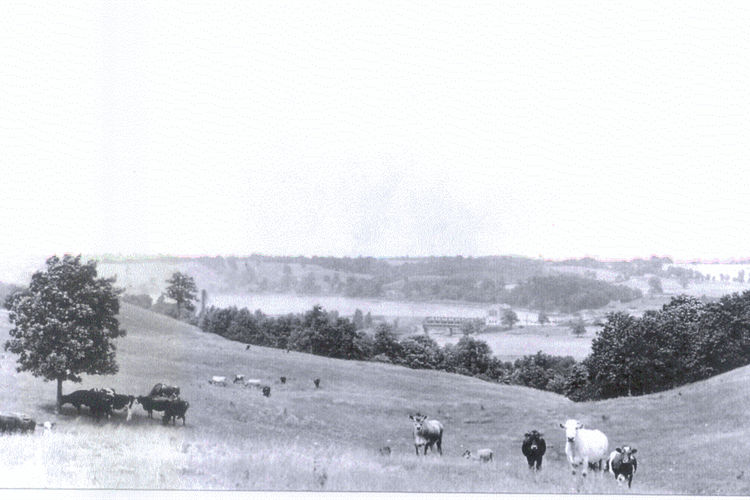History
Ann Arbor's city parks sit on the ancestral and traditional homelands of several indigenous Native peoples. Read a
land acknowledgement from the city and learn more about the early history of the land
here.
Bird Hills has an interesting and varied land use history that adds to its significance as a park. Old photos indicate that the property was logged in the late 1800s. The central ridge and slopes were barely spotted with trees and were heavily grazed by cattle. Some remnants of the park’s agricultural past are still visible today. Old concrete tracks mark the site of a farm road designed to fit the wheels of a wagon, while letting the horse or ox pulling the wagon walk on softer ground between the tracks. The northwest portion of the park was used as a terraced fruit orchard.

A picture of the land being used for grazing, sometime after the Bartom Dam (visible in the background) was completed in 1813
In the early 1900s, Henry Graves and his nephew Winfred Bowen bought the property to develop as a high quality subdivision. At this time much of the main ridge in the park was still cattle pasture and was nearly treeless. View this 1927 photo of Bird Hills. The absence of plant cover increased the amount of runoff from the high ridge after a rain event. This caused severe erosion in the steep ravines running down to the river.
To make the land more appealing for potential home owners, Henry Graves planted a variety of trees on the open site. This contributes to the diversity of woody plants in Bird Hills today, and explains why many non-native trees such as Scots pine, Douglas fir and white fir can be found there. However, these development plans never came to be as Graves eventually changed his mind about development (read more
here).
In 1968, the majority of the
parkland was purchased by the city for $319,634. In the 1970s, when plans to create a condominium complex next to the park surfaced, neighbors and other
citizens rallied and raised enough money to help buy the land. Again in 1990, more land adjacent to the now-larger park was threatened by development, and again the citizens and city teamed up to buy the land to add to the park.
It is likely that the overstory, and certainly the understory, that existed at Bird Hills 200 years ago was different than it appears today. In addition to the introduction of non-native species, the composition of flora has also been influenced by prevention of naturally occurring fire. As fires regularly moved through Washtenaw County prior to European settlement, the forest understory was thinned, and the overstory was more open, allowing native species such as oak and hickory to flourish. Without naturally occurring fires, some of the forested areas of Bird Hills have become better suited for shade tolerant
non-native and invasive species such as Norway maple, white ash, and buckthorn. If the forest is allowed to develop in the absence of fire, non-native species will dominate and out-compete the native plants for light, space and nutrients. This is why Natural Area Preservation (NAP) conducts controlled fires in Bird Hills during the spring and fall.
The rich diversity of
native plant species found in Bird Hills ranks the park second highest overall in the city’s Floristic Quality Assessment of its natural areas. This high value gives an indication of how “natural” the site is (approximating the vegetative conditions present prior to European settlement in the early 1800s). A higher value reflects a higher coefficient of conservatism for the species growing in that area. These conservative species have become so highly adapted to a specific set of biotic and abiotic conditions (including soil condition, temperature, moisture, humidity, presence of fire, etc.) that they cannot exist if these conditions are modified evenly slightly. So, when you encounter these species in the wild, as you do in some of the biological communities at Bird Hills, you can be fairly confident that you have come across an area that is about as 'natural' and undisturbed as we can find in our modern world.
To read more about Bird Hills Nature Area history, volunteer efforts, ecological restoration and other Natural Area Preservation activities, check out the NAP Newsletter features that have highlighted Bird Hills:
1998 Restoration Focus: Bird Hills Nature Area by Kathy Sorensen
2005 Park Focus: Bird Hills Nature Area by Shelley Gladwin
2013 Park Focus: Bird Hills Nature Area by Yousef Rabhi
